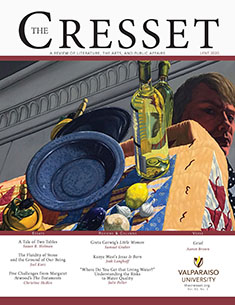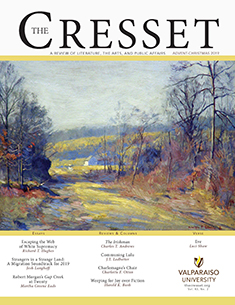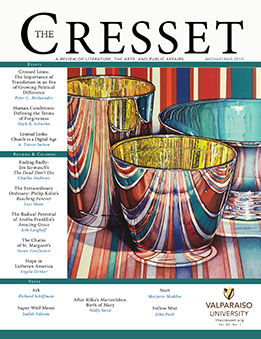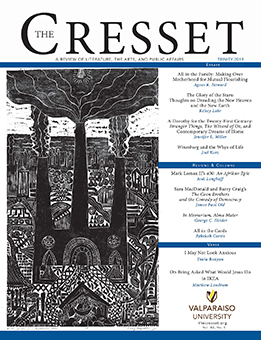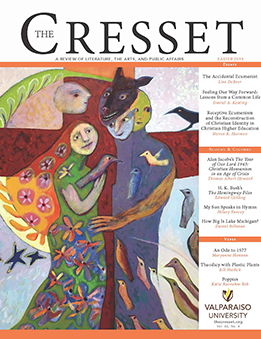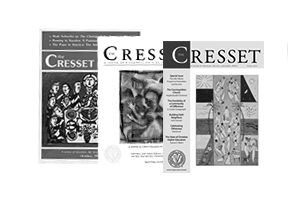A Mercy. New York: Alfred A. Knopf, 2008.
Imagine for a moment that it is 1682: the United States of America has yet to be organized, the laws of the land are fluid, and the slave trade is in its early stages. Somewhere at the edge of the forest in New York, there is an empty mansion with a faint glow coming from one of the rooms. Inside, a young Portuguese slave, no more than sixteen, is “carving words” along the walls and floor. She holds a lamp in one hand, a sharp nail in the other. She is exhausted, but cannot stop until she’s finished telling her story: “There is no more room in this room. These words cover the floor.... My arms ache but I have need to tell you this” (161).
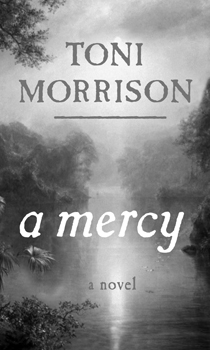
Desperate, passionate, and love-starved, Florens is the central voice in Toni Morrison’s latest book, A Mercy. The novel depicts Florens’s journey as a slave, beginning when she is sold to a Dutch trader, Jacob Vaark, as payment for an outstanding debt. At Jacob’s estate, Florens becomes part of a diverse group of laborers maintaining his farm. There are two other slaves: Lina, a hard-working, caring Native American woman whose tribe was wiped out by smallpox, and Sorrow, a melancholy young woman with an equally traumatic albeit enigmatic past at sea. There are also two indentured servants, white gay men who escaped hardships in England by coming to the colonies. Similarly, the mistress of the household, Rebekka, avoided religious persecution in England by traveling to the colonies to marry Jacob, a man she had never met. Jacob, an orphan, worked his way out of the poorhouses to financial security. A collection of damaged souls, this motley cast of characters forms a sort of “companionship out of isolation” (156), and in their community Morrison offers up an alternative way of being whose mere existence challenges the history of slavery in America.
In a interview with Sam Tanehaus of the New York Times Book Review (“A Conversation with Toni Morrison,” 30 November 2008, video.nytimes.com), Morrison explains that “Dividing the world up ethnically or racially was a deliberate sustained event that grew, but before that, I just wanted to suggest what it [the United States] could have been like, what it might have been like, before the narrative that we have now about the beginnings of this country.” To illustrate this possibility, Morrison includes another character, a free African blacksmith, hired by Jacob to craft iron gates to surround the ostentatious mansion he is building. Florens is instantly attracted to and enamored of the handsome, haughty blacksmith and the two surreptitiously become lovers.
A Mercy is the ninth novel in Morrison’s body of work, and its colonial setting is the earliest in her writing. In her fresh and dream-like rendering of the landscape, America is an uncharted Eden. Morrison explains her choice of setting, “I was looking for a time before slavery and black became married, before racism became established, and slavery was the most common experience of most people” (“A Conversation with Toni Morrison”). In the 1680s, slave labor had not yet become an important source of profit, but the beginnings of racial tension and division were present. Early in A Mercy, Morrison informs her readers that after a 1676 uprising by the lower-classes against the gentry—a rebellion that united whites and blacks; slaves, indentured servants, and freemen—the authorities responded “...by eliminating manumission, gatherings, travel and bearing arms for black people only; by granting license to any white to kill any black for any reason; by compensating owners for a slave’s maiming or death, they separated and protected all whites from all others forever” (10). Although Jacob himself rejects these “lawless laws,” several incidents in the novel demonstrate a growing prejudice.
The kinship between the workers on Jacob’s farm begins to dissipate after the completion of the mansion and its master’s untimely death. After Jacob passes away from small-pox, Rebekka and the three female slaves are left to fend for themselves on this farm in the wilderness. With Rebekka infected by the virus that killed her husband and no male heirs to inherit control over the estate, the fate of these soon to be “unmastered women” is unclear: “Female and illegal, they would be interlopers, squatters, if they stayed on after Mistress died, subject to purchase, hire, assault, abduction, exile” (58). On her deathbed, Rebekka recognizes this danger and sends Florens on a mission to find the blacksmith Florens pines for. But the blacksmith rejects Florens, and her feral reaction leaves her etching her tragic story on the walls of a bare room in Jacob’s mansion.
Like its heartbroken protagonist, the novel as a whole has a sort of confessional, serious quality; it aches to be read and digested. Each character has a unique story to tell, and Morrison, in her characteristic Faulknerian style, grants most of them a turn or two in advancing the novel’s plot via third person limited perspective. These interludes are interspersed between chapters from Florens’s perspective, which is communicated using first person narration and is occasionally confusing (given her muddled syntax), and they serve as excellent compasses for reorienting the reader in space and time. The voices build on one another, adding depth and color to the novel while balancing out Florens’s lovesick drone. At times, the supporting characters are even more engaging than the heroine, and one may finish these chapters wanting to know more. Morrison, however, is intentional in her economy. These narratives are only threads in a greater tapestry.
Echoes of Morrison’s Pulitzer-Prize winning novel, Beloved, abound throughout the text, including motifs of womanhood—its struggles and triumphs—and mother-daughter relationships. The narratives of the women in A Mercy lucidly portray the difficulties inherent in the feminine experience in the 1680s, as summarized by Lina: “We never shape the world... the world shapes us” (71). Each female character experiences this lack of power and control in varying degrees, but it is best illustrated in the poignant, appalling life story of Florens’s mother—her capture, path to slavery, the brutal rape, and continued abuse she suffers from the men on her master’s plantation. It is no wonder that when Jacob suggests the acquisition of Florens’s mother to settle an unpaid debt with her master, she begs Jacob to take her daughter instead: “Take you, my daughter. Because I saw the tall man see you as a human child, not pieces of eight [coins]” (166). Her mother’s action changes Florens’s environment and life circumstances for the better, but it leaves her feeling heart-broken and dejected. Craving the unconditional love that can come only from a mother, Florens is desperate to care and be cared for. Her neediness first draws her to Lina and later to the blacksmith. But the blacksmith rejects her slavish devotion, and Florens becomes wild with hurt and anger.
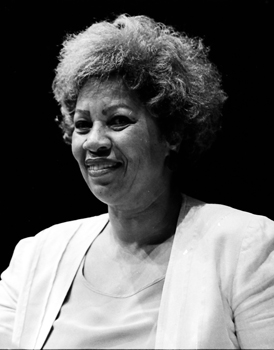
Like Florens, every woman in the novel is touched by “Mother hunger—to be one or to have one” (63). Motherhood is an empowering role in Morrison’s fiction, one that brings a sense of purpose and identity. Although she has felt lost and alone for most of her life, Sorrow’s sense of self is dramatically altered by motherhood. After giving birth, Sorrow’s sense of self is dramatically altered by motherhood. After giving birth, Sorrow looks into her child’s eyes and decides from that point on she will call herself Complete. This scene is a glimmer of hope amongst many dark moments in A Mercy.
Thought-provoking and unique in scope, Morrison’s latest work gives voice to those whose voices are so often muted within history, revealing the legacy of the sexism and racism that pervades contemporary society. With subtle grace and deft, Morrison writes of heart-wrenching hardships, ugly realities, and small mercies—acts of kindness which restore for us some faith in humanity (even though these moments are few and far between). The final passage and message of A Mercy seems to have come straight from the author, channeling her voice through Florens’s mother. She says, “To be given dominion over another is a hard thing; to wrest dominion over another is a wrong thing; to give dominion of yourself to another is a wicked thing” (167). As each of these scenarios are fulfilled in the novel, readers are reminded that whether literal or figurative, slavery engenders evil. Even though she cannot physically hear her mother’s thoughts, Florens ascertains the same truth. Her story-telling becomes a path to self-discovery in which she reclaims her heart and voice: “I am become wilderness but I am also Florens. In full. Unforgiven. Unforgiving. No ruth, my love. Hear me? Slave. Free. I last” (161). A
Erin Dalpini works in Chicago as an Editorial Assistant at Fourth Presbyterian Church.


